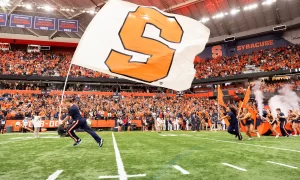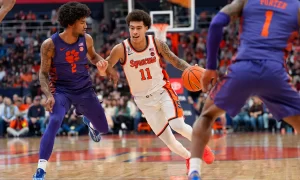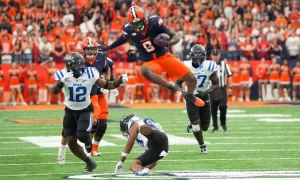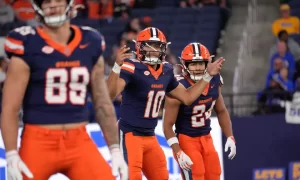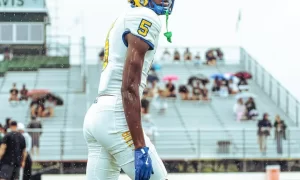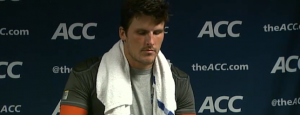 The first game of the Drew Allen era at Syracuse is in the books, and it was, interesting, to say the least. The offense struggled to move the ball, only scoring touchdowns after a 55-yard pass and a long interception return set them up with extremely short fields. Even then, the Orange could only score on running plays. Allen finished the game just 16/37 for 189 yards, which is even worse when you consider he started 6/6 for 43 yards. Allen was not impressive, he looked lost at times in the second half, underthrew balls, and was a far cry from what many Syracuse fans expected.
The first game of the Drew Allen era at Syracuse is in the books, and it was, interesting, to say the least. The offense struggled to move the ball, only scoring touchdowns after a 55-yard pass and a long interception return set them up with extremely short fields. Even then, the Orange could only score on running plays. Allen finished the game just 16/37 for 189 yards, which is even worse when you consider he started 6/6 for 43 yards. Allen was not impressive, he looked lost at times in the second half, underthrew balls, and was a far cry from what many Syracuse fans expected.
Following the Spring Game, much was made of chemistry between Terrell Hunt and Jarrod West. West was supposed to be the go to man in a group of inexperienced receivers. Instead, West had just three catches against Penn State, and there looked to be no chemistry between he and Allen. On multiple occasions, Allen threw passes where he expected West to be, only for West to break later or keep running. Allen even admitted that the communication was off between him and his receivers.
“I felt like there were times when we showed a lot of great things, and then there were times when things weren’t so great. And I felt during those times it was when our communication broke apart.”
On the other hand, Allen seemed to trust Ashton Broyld as his go to receiver. Broyld made a key catch for a first down on a third and long, as well as turning short screen passes into longer gains. After a few connections, Allen began to target Broyld so much the defense easily read the throw before it even left Allen’s hand, leading to incompletions and an interception. It isn’t bad that Allen has found trust in Broyld, but he needs to develop that with West and the rest of the wide receivers. Without it, the offense will not be able to move the ball down the field.
Allen also looked uncomfortable in the offense. Many times, the graduate student looked over towards the sideline shrugging in the direction of George McDonald. He took a delay of game penalty, was forced to call a timeout to avoid another, and would have been forced to call another timeout if not for the end of the quarter.
Allen was also unsure of plays to audible to when the situation presented itself. Allen has only been in the offense since May when he graduated from Oklahoma, but he has to be comfortable with the playbook. Another interesting part about the offense was the use of the Pistol formation. The Orange actually ran an option on the first play of the game, then probably thought better and didn’t have Allen run another. The Pistol would seem much better suited for Hunt than Allen, so why would the SU coaching staff force it?
What happens if Allen struggles again? If he starts 6/6 and is on his way to 10/31 the rest of the way, will Shafer pull the plug? Will Hunt get a chance if the Orange is down against Northwestern this weekend and Allen is struggling? Shafer may not have wanted to pull Allen in his first game, but it would be borderline inexcusable if Shafer allows the quarterback to falter again. The Orange should not use a two-quarterback system, but sometimes when a player is struggling, he needs a break. It happens all the time with other players, whether it is the corner who was burned on multiple plays or the wide receivers who drop two or three passes. This may be different because it is a quarterback, but it wouldn’t be a rash decision made because of two or three bad passes. It would be five or six bad quarters of football. Maybe it wouldn’t be the worst thing in the world for Allen to sit down for a quarter if he struggles in Evanston this weekend.
Bottom line, Allen did not look good in his first start for the Orange and his first since high school. Allen needs to play better, work with receivers other than just Broyld. If the Penn State defense was able to tell which receivers he was locked into, what is a better Northwestern defense going to do? Allen needs to improve, otherwise Orange fans could see Hunt against Wagner, and maybe even sooner.
Posted: Seth Goldberg




